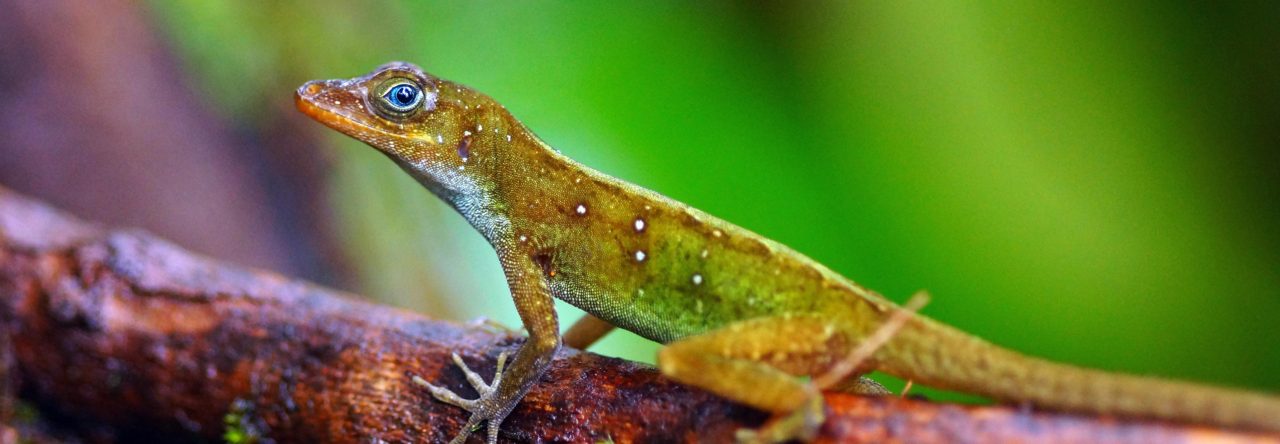Through the years here at AA, we’ve had discussion of the habitat use of the common green anole. In particular, there is a persistent belief that before the brown anole emigrated from Cuba, green anoles used all manner of anole habitat, from the bottom of trees to the very top of the canopy. Once the browns arrived, however, greens seem to have repeated back up the tree, ceding the low perches to the browns.
This is a very nice story, and probably true, but it’s surprising how little documentation we have of the habitat use of green anoles in places where browns don’t occur. In fact, more generally, it is quite surprising just how little we know about the natural history of green anoles throughout their natural range. For such a common species, you’d think its biology would be extremely well-known, but that is far from the case.
A while back, Janson Jones referred to the green anoles in his then-neighborhood (he’s since moved) in Georgia as low-riders, a possible example of green anole habitat use in the absence of browns. With this in mind, I was delighted to get a chance to see what the greens are up to in Alabama, a state that is still mostly–at least for now–mostly brown anole free.
On the campus of the University of Alabam in Tuscaloosa, greens were moderately abundant when the sun was out. The fellow to the right was strutting his stuff on sorority row, but his comrades elsewhere were in similar habitats on trees, moving up to into the canopy when harassed by an old dude with an iPhone.
But then I had the good fortune to get taken to a nearby pine forest by whiptail lizard geneticist turned turtle biologist Peter Scott, a grad student at UA. Peter told me that he often saw (or, rather, heard) green anoles scurrying through the leaf litter when he approached, running to the nearest tree which it then ascended. It seemed unlikely, but sure enough, that’s where the greens we found were, down low, in very un-green anole-like habitat.
Of course, these were just a few observations made over the course of a short hike one afternoon. But clearly there’s a lot to learn about green anoles–what they do in places without competitors, and how that changes when brown anoles arrive. Seems like a great project out there, just waiting for someone to do it.
- Evolution in Real Time on Lizard Island - March 23, 2025
- Spider Snags Adult Anolis osa - March 22, 2025
- An Homage to the Green Anoles of New Orleans - March 21, 2025





Kenneth Barnett
Nicely written, and great points.
Skip Lazell
We “winter” in Jackson, Mississippi, and have lots of green anoles that forage on the ground a lot. No browns yet…. Skip
Sean Giery
Earlier this spring (March-April), before leaf-out, I observed quite a few green anoles perched on rocks and logs in mixed deciduous forests here in North Carolina. They had presumably recently emerged from overwintering microhabitats, and might have been reluctant to move from these thermally protective sites (probably a good idea, since it reached freezing temps subsequently). More recently (this past weekend), with the passing of freeze threat and a newly-closed canopy, anoles are obviously moving up into shrubs, and onto trees.
Are these northern populations more terrestrial for thermal reasons? If so, observations during spring/fall might differ from summer. Such ‘forced’ terrestrial habitat use in the colder portions of the green anole range might be an important aspect of habitat use/niche width in northern vs. southern populations. Are abiotic factors more important for habitat use in northern populations? And how might a seasonal dependence on terrestrial habitats affect the importance of biotic factors such as predation (e.g., black racers) and interspecific competition (e.g., brown anoles)? Surely, there is a lot more to investigate regarding green anole ecology and their large range presents many opportunties.
Marc Tollis
During a winter in South Carolina, I observed green anoles basking in the weak sunlight at about ankle-height on walls and downed trees into the late afternoons. I guessed they were down there because the angle of the sunlight and air temperature at ground level were more suitable for thermoregulation during the winter. Then again, way up in the Smokey Mountain foothills near Knoxville TN, we saw lots of green anoles in the pine-coney leaf litter, and in high densities, during a record hot summer (above 95F for more than a month). So there went that hypothesis. My guess is that without competition these guys will crawl about anywhere.
Bill Bateman
In central Florida I saw green anoles hanging out on low palmetto growth out in the long-leaf pine woods. No browns around that I saw.
Skip Lazell
In my youth I came to Jackson, MS, in the summers and saw and caught green anoles foraging on the ground and perching low then, too. They also went, and still go, high. Skip
Steven A. Nole
Green anoles and brown anoles appear to coexist in this neck of the woods.
The greens here seem more active and opportunistic than their brown cousins, they’re more likely to root around in the leaf litter for bugs and spiders; whereas the browns will more often sit and wait for something to emerge.
They’re also more likely to hang around trash cans and feed on the abundance of flies.
The greens seem less wary of humans, more tolerant of colder weather, and smarter in their choices of hiding spots.